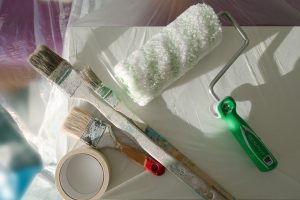blogger: Cynthia Ruchti
How IS writing like painting?
Although, yes, writing at its best is art.
For today’s blog post’s purpose, let’s think about this kind of painting and its correlation to writing:
If you’ve done any remodeling in your home, even as minor as painting a feature wall, you know that the project doesn’t happen magically. To do the job with excellence and enjoy the end product, the painter–amateur or professional–pays attention to many vital steps.
Prepare the surface
What’s the equivalent of removing old wallpaper or scraping peeled and curling paint for a writer? It might mean discarding preconceived notions about your theme or subject so you can get all the way down to the truth. Preparing the surface can also be the writer’s pre-writing process. Clearing away debris-thoughts. Imagining the finished project, and letting that override resistance to all the work that stands between this moment and the book’s glorious THE END. 
It may also mean patching holes, smoothing out rough spots, or filling gaps in the writer’s education or research. It could mean dealing with water damage and stains. To a writer, that may be emotional wounds and prejudices that could bleed through the new coat of paint, or bleed through a stain a story.
Collect your tools
Professional painters know they could paint a whole house with a toothbrush, but it would be bogglingly inefficient and tedious. Writers can write a book on cocktail napkins or scraps of paper stored in shoeboxes. But again–both inefficient and laborious. Why do we sometimes try to write with literary toothbrushes? Not taking time to or making the investment to upgrade software. Not stopping to find that characterization file. Procrastinating on defragging a hard drive. Ignoring the issues that are slowing a computer or making it crash periodically… Any of these irritations can cause an author so much distress and distraction that little work gets done, or cleanup at the end is more challenging.
A wise painter lays a drop cloth over the floor to prevent costly spills. How does that relate to your process as a writer? What’s a writing tool you use often that could benefit from an upgrade not only for efficiency but to create a beautiful finished product?
Ensure proper ventilation
Since the invention of low-VOC paint (with lower levels of dangerous to inhale volatile compounds), homeowners don’t have to be as concerned as they once were about adequate ventilation when tackling a painting project. But writers still do. Creativity benefits from sunshine and fresh air. Writers who hold their breath while crafting tense scenes may need to step away from the computer and breathe. A brain deprived of oxygen does not a good book make. (It’s a legitimate point. Schedule deep breathing breaks if you need to boost your brain’s ability to find that perfect word you’re looking for.)
Pay special attention to cutting-in
Cutting-in is the term for the detail work of painting around window trim, edges, light switches, doorways, or along the mopboard. It can be time-consuming and intense, but done well, it’s a clear demonstration of the level of professionalism.
For writers, cutting-in represents handling delicate topics. Being thoughtful about tough themes. Working around issues that are often misunderstood. Creating a character who is both villain and victim.
Take time cutting-in, writers. Publishers and readers may not know the effort you invested, but they will appreciate the crisp look of the finished product.
A second coat and touch ups
Despite the claims of high-end paint products that claim “one easy coat,” many paint jobs require at least a second coat. Even the best writers go back through their work to make sure everything’s covered. Are loose ends tied up? Plot points fully resolved? The character arc clear? For nonfiction, that second coat can be watching for flow issues, pacing, double-checking details.
The last thing a house flipper does is make one last round to take care of touch ups. The flipper is on the lookout for spots that were missed originally, or dings that happened during the rest of the remodeling or staging. Glaring typos, like an obvious bare spot on freshly painted woodwork, can make a prospective buyer–or agent/editor/reader–wonder if the writer took other shortcuts.
We can find writing parallels all around us. What was it about this one that brought something to mind about your own writing process?



Having spent a long time learing to paint the old-fashioned way…
There’s still preparation of the canvas (which can be pretty complex, not just tossing some gesso on it), the design of the composition, the ource of light, perspective, and the path they viewer’s eye follows to the ‘plot climax’…and yes, there’s a denoument.
F.E Church and Albert Bierstadt are masters of this; so, of course, is Thomas Cole. You don’t see ‘them’ in their paintings (as you do Monet and Signac); you see a story that is nonetheless told in a distinctive voice.
Writing can be quite the trip,
an Impressionist tour de force
like Cormac McCarthy (oh so hip!)
on a mad dystopian horse.
But I prefer the settled state
of the Hudson River School,
chock-full of details we create
to let our characters rule.
I much prefer to write in thrall
to people who become so real
in heart and mind, and heed the call
to make a world we can touch and feel.
I’d rather not take the main prideful part,
but sooner meet you in my character’s’ hearts.
To illustrate the “eye’s path”, which follows a spiral to the central point (which is never in the center of a canvas, by the way), consider a cinematic example – the last of the Hobbit Films, the Battle o the Five Armies.
After the opening, in which Smaug ravages Lake-Town and is thereby killed, there are several sub-plots which will intersect at the battle for Erebor:
1 – the journey of the Erebor dwarves to take possesion of their old home
2 – the journey of the survivours of Lake-town to find shelter in the ruins of Dale, and perhaps shelter (and the means to rebuild) in Erebor
3 – Gandalf’s rescue from Dol Guldur and his effort to warn the men and elves in Dale, and the wdarves in Erebor, that war is coming.
4 – the ‘relational’ journey of the elves Legolas and Tauriel to Gundabad and thence to Dale
These four main themes can be taken as quarter-slices of a pie, and the storytelling arc spirals in from their original presentation to their confluence in the final battle for Erebor.
Each ‘slice’ is treated with respect, as a vital part in the story, and the viewer is allowed to absorb the culminations of the interim vignettes on the ride ’round the gyre.
The ‘off-center’ climax is, of course, the death of Thorin Oakenshield, and the open question of who will now lead the dwarves.
I have no idea whether this is in any way coherent (or applicable!), but it was sure fun to write!
🙂
I have a sudden urge to visit an art gallery and look for the spirals I didn’t realize were there!
I haven’t read those Tolkien books in decades. Your post made me want to read them again.
Cynthia, what a great analogy for painting and writing. They are both arduous processes, but done right and done well, they add beauty to their environments.
And now I’m curious . . . have you done some painting recently? 😉
Still mudding and taping, but the painting will soon commence on my reading room. 🙂
Love this! Yes, writing is like painting. 🙂
Cynthia, this is a great analogy; it paints a beautiful word picture for me. Your thoughts inspired mine and made me wonder what word picture would best describe my writing.
The picture of a cuckoo bird came to mind. She lays her egg in another bird’s nest and expects that bird to raise her offspring. I often get an idea out of nowhere. It makes its home in the nest of my mind and hatches. Now it sits there and demands feeding, utterly disproportionately to my ability. It’s yelling at me all the time … I think I am going crazy (or cuckoo) 🙂
Thanks for the mind-jog this morning. LOVE your posts!
Heidi, your word picture brought a lot of joy this morning!
Cynthia,
Back in my teaching days, I used many an analogy to explain a complex concept in a simple way. You’ve nailed it.
Thanks,
Renee
And then I sometimes have to go back and patch the holes the nails made in the dry wall!
Ha! I just painted the ceiling and walls of one of the cabins at the camp where we live and work with a friend of mine. What struck me was how apparently one uses every single muscle in their body to paint a ceiling. I was sore for days afterwards. I have been working on articles and critiques for friends and gotten away from my manuscript lately. My painting analogy is that I better get back to that story before all my painting muscles get soft, leaving me sore for days!
Love this parallel!
Painting and photography helped me understand the “voice” aspect of writing.
Great reminder of how the attention to process and detail is worth the hard work both in painting a room or writing a book.